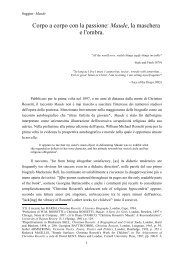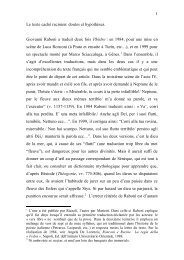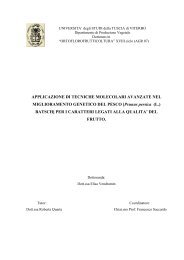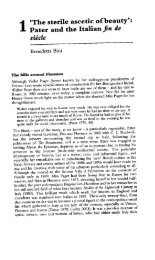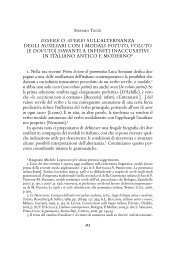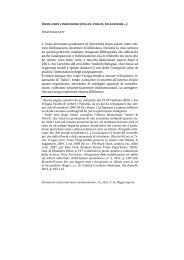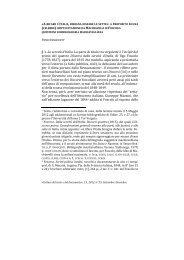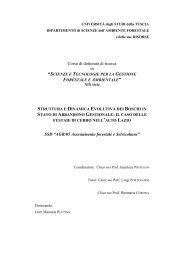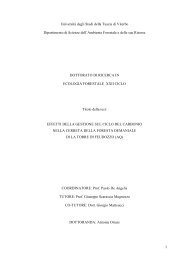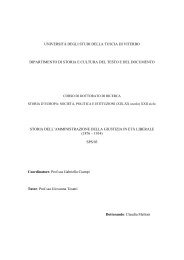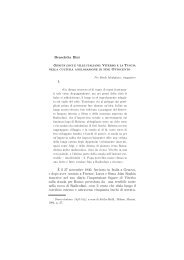drivers of soil respiration of root and microbial ... - Unitus DSpace
drivers of soil respiration of root and microbial ... - Unitus DSpace
drivers of soil respiration of root and microbial ... - Unitus DSpace
Create successful ePaper yourself
Turn your PDF publications into a flip-book with our unique Google optimized e-Paper software.
5.2.3. 14 C labeling <strong>and</strong> 15 N application<br />
Corn plants were divided into two groups with twelve plants in each. The first group <strong>of</strong><br />
plants was labeled with 14 CO2 on the sixth leaf collar stage (V6 corn), the second group was labeled<br />
on the eighth leaf collar stage (V8 corn). Preliminary studies showed that about 2 weeks after<br />
germination, corn starts to increase its biomass linearly. So, the uptake <strong>of</strong> water <strong>and</strong> nutrients,<br />
inclusive N, on the mentioned stages is nearly linear <strong>and</strong> therefore, the results can be extrapolated<br />
for longer periods. Twelve plants <strong>of</strong> lupine were labeled on the 36 th day after germination, the<br />
eleventh leaf collar stage (V6).<br />
One day before the respective labeling, the top <strong>of</strong> each pot was sealed with a silicone paste<br />
(NG 3170 from Thauer & Co., Dresden, Germany). The seal was tested for air leaks. Pumping the<br />
air through the <strong>soil</strong> column before labeling flushed out the CO2 accumulated in the <strong>soil</strong> during the<br />
plant’ s growth.<br />
Three N treatments were applied four hours before each 14 C labeling: (a) a control treatment<br />
without any added N, (b) an ammonium treatment, with 15 N as ( 15 NH4)2SO4 <strong>and</strong> (c) a nitrate<br />
treatment, with 15 N as K 15 NO3. Four plants <strong>of</strong> each specie <strong>and</strong> growing stage were exposed to each<br />
N treatment. Dicy<strong>and</strong>iamide (DCD) at 20 mg kg -1 <strong>soil</strong> was applied in solution with 15 N fertilizer to<br />
all treatments in order to achieve an effective nitrification inhibition throughout the <strong>soil</strong> column (in<br />
the ammonium treatment) <strong>and</strong> to balance the side effects <strong>of</strong> the inhibitor (in the nitrate <strong>and</strong> control<br />
treatments). The amount <strong>of</strong> 15 N applied to a pot was calculated to produce an average concentration<br />
<strong>of</strong> 60 mg <strong>of</strong> N kg -1 <strong>soil</strong> for each N species added. Four unplanted pots were fertilized with half<br />
amount <strong>of</strong> nitrate or ammonium to estimate the effect <strong>of</strong> N fertilization on <strong>respiration</strong> <strong>of</strong> <strong>soil</strong><br />
microorganisms.<br />
The 14 C labeling process has been described in detail by Kuzyakov et al. (1999, 2001) <strong>and</strong><br />
Domanski et al. (2001). Briefly, sealed pots with plants were put in a plexiglas chamber, 14 CO2 was<br />
introduced to the chamber by adding 1 mL <strong>of</strong> 5 M H2SO4 to a Na2 14 CO3 (1.5 MBq) solution. This<br />
allowed complete evolution <strong>of</strong> 14 CO2 into the chamber atmosphere. After a 2h-labeling period,<br />
trapping <strong>of</strong> CO2 from the chamber through 10 mL <strong>of</strong> 1 M NaOH solution was started to remove the<br />
remaining unassimilated 14 CO2. When the chamber was opened, pots with the plants were<br />
connected by tubes to an output <strong>of</strong> membrane pumps: air was pumped through every single pot<br />
from bottom to top. Another tube was connecting each pot to a CO2 trapping tube, filled with 3 mL<br />
<strong>of</strong> 1 M sodium hydroxide (NaOH) solution. The output <strong>of</strong> the trapping tube was connected to the<br />
input <strong>of</strong> the membrane pump. Therefore, the air containing CO2 evolved from the <strong>soil</strong> <strong>respiration</strong><br />
was circulating in a closed system: from the plant-<strong>soil</strong> system to the trapping solution to the<br />
membrane pump <strong>and</strong> back to the plant-<strong>soil</strong> system.<br />
125




